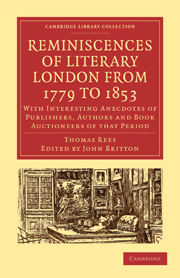 Reminiscences of Literary London from 1779 to 1853
Reminiscences of Literary London from 1779 to 1853 Part I - PATERNOSTER ROW AND ITS VICINITY
Published online by Cambridge University Press: 29 August 2010
Summary
Near the close of the eighteenth century, “The Row, ” as it is now popularly called, contained two or more printing establishments, one of which was conducted by the late “George Woodfall, ” who had succeeded his father, Henry Sampson Woodfall, well known as the printer and publisher of the “Public Advertiser, ” in which appeared the far-famed “Letters of Junius.” The latter was still living, and X had the pleasure of seeing him in the enjoyment of a “green old age, ’ when I first visited London. Those daring epistles, with the newspaper in which they were published, excited intense curiosity during the course of their publication. There were also two houses of wholesale stationers; one belonging to the family of Key, and the other to Peter Wynn. The University of Oxford had, under the management of Mr. Gardner, a depot to supply the London trade with their editions of Bibles and Prayer-books. But with these, and a few other exceptions, the majority of the houses were tenanted by persons who were strictly, in the ordinary sense, Booksellers. The varieties of these may be classed under three divisions. The first comprehends publishers only, whose sale of books was confined to their own property. The second might be designated book-merchants, who were chiefly wholesale dealers, and carried on an extensive and important trade with country booksellers; they were also publishers upon a large scale, both of periodicals, under the designation of magazines, and reviews; and likewise works on general literature and science, of the larger and more important and costly descriptions.
- Type
- Chapter
- Information
- Reminiscences of Literary London from 1779 to 1853With Interesting Anecdotes of Publishers, Authors and Book Auctioneers of that Period, pp. 17 - 88Publisher: Cambridge University PressPrint publication year: 2010First published in: 1896
